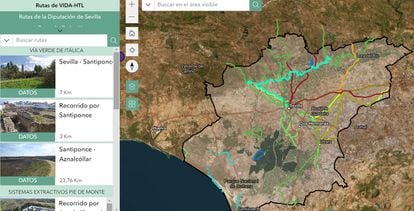An image of an olive grove, a farmhouse, a mountainous area or a sunset on the coast is not a landscape, it is a miniature, a minimal expression of something complex. The landscape is a part of the territory where perception and human interaction with it define what and why we are, have been and will be. A simple route from the Monastery of La Cartuja in Seville to the nearby town of Valencina allows you to explore more than 4,000 years of history, from contemporary art to prehistory. Reflecting this complexity in a web application has been the challenge, monumental in all its senses, of the Heritage, Tourism and Landscape Networks Laboratoryfrom the School of Architecture (ETSA) of the University of Seville, a research group that has created the first development of a tool (VIDA HTL) for the user to create itineraries that go unnoticed because they are outside the urban and massive tourist circuit.
“The territory is not a plane,” summarizes Mercedes Linares, co-researcher at the HTL laboratory, acronym for Heritage Tourism Landscapes (Landscapes Tourism Heritage). With this basic and complex premise, the university group of 21 members has been working on the project for years. Smarch (acronym of smart architectural and archeological heritage or intelligent architectural and archaeological heritage), a work that allows linking technological specialists with others related to cultural assets. From this relationship, the virtual developer project was born two years ago, the application that allows the results of that interaction to be applied and transferred to users.
The initiative is an emulsion of tourism and culture born from the enormous richness of both aspects and the situation they face. “In some large capitals, mass tourism is excessive. We have been working for years on heritage linked to the landscape, on diversifying tourism and taking it to where there is an enormous unknown heritage that, in addition, allows us to explain historical dynamics,” explains Antonio Tejedor, principal researcher of the project.
The final mission of the work is that the result is a dynamizer, an “activator of heritage”, something that, according to Tejedor, “is a factor of quality, of identity, of economic value.”
The initial funding (about 85,000 euros from the Ministry of Science and the EU’s Next Generation funds) has forced us to delimit in space (73 municipalities in the lower Guadalquivir) and in technological development this first germ of a tool that, today, is a demonstrator that aspires to spread with the collaboration of administrations and universities. The app is free and the group is open to sharing their experience. “We are university students, professors. Our interest is research,” comments the architect to rule out a commercial interest in the project.
Whether the tool, now accessible only through the computer, makes the leap to mobile will also depend on this collaboration. “It is an arduous work that will require extra funding because the mobile phone does not allow you to see the layers of information simultaneously,” justifies the main researcher.
The application has another relevant uniqueness compared to others with similar objectives: it is collaborative. The user is part of it and not only because of the ability to design their own routes. Whoever registers becomes part of the network to provide proposals, suggestions, warn of deficiencies, include complementary services to the itinerary or even schedule related events. In this way the circle is closed and the heritage once again belongs to its main defender, the person.
The application already contains the registry of a thousand cultural assets – architectural (80%), archaeological and infrastructure – whose files have been simplified to facilitate navigation and adapt them to the needs of the most common user. And it continues to grow. The lack of information about roads outside the main communication routes is being solved and the list of heritage in the area is constantly being completed.
The main page of Vida HTL starts with a map that locates all the heritage assets included in the area, which covers Seville, Huelva, Cádiz and a municipality of Córdoba. The advanced search allows you to select assets by municipality, type, historical period, use, state of conservation or accessibility.
The user can choose one of the already prepared routes or design their own. Each of the assets has a specific file and allows access to a website with more detailed information about the heritage, knowing the opinions of users and creating a personal space with personal preferences.

The proposal is part of the latest trends in approaching heritage. Xiang Zhoy, lead author of a study published in Landscape Architecture Frontiershighlights that what he calls “heritage corridors” represent a “method of systematic conservation of historical, cultural and landscape resources” that, in addition, “provides the public with continuous linear spaces for recreational activities.”
“Most traditional studies on heritage corridor route planning focus on the analysis of physical spatial conditions, ignoring public perception and participation mechanisms,” comments Xiang Zhoy, who advocates for the “effective integration of landscape resources with public recreational behaviors and spatial perception in the route planning process.
The incorporation or adaptation of technologies with heritage experience is also a key aspect. Tobias Höllerer, one of the directors of Four Eyes Lab, argues that the effects of applications continue after the devices have been deactivated: “Technology increases the human capabilities of users: awareness, new skills, new attitudes, new mentalities. Even when technology dies down, just because people have experienced it, it can help the humanity of humans.”
You can follow The USA Print in Facebook and x or sign up here to receive our weekly newsletter.
Subscribe to continue reading
Read without limits
_






